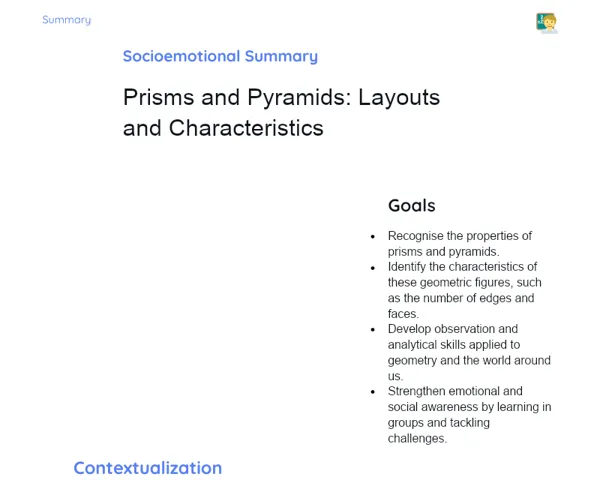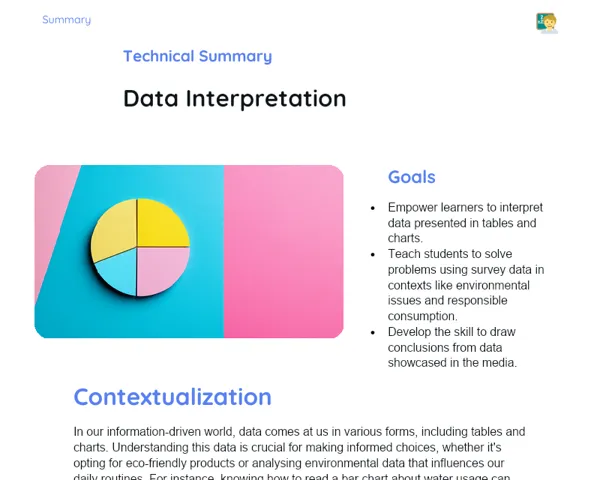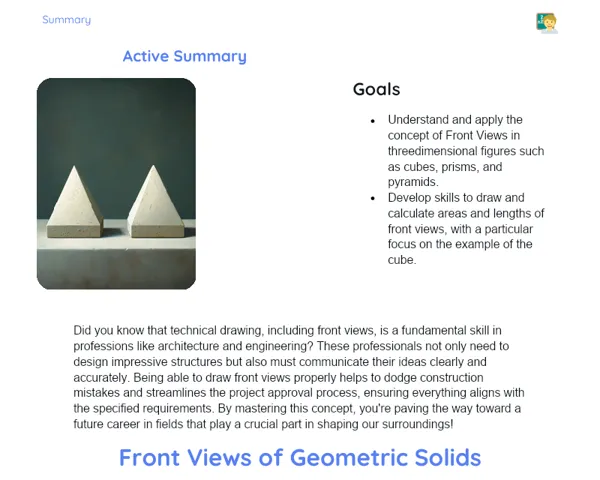Summary Tradisional | Spatial Geometry: Frontal Views
Contextualization
Spatial Geometry is a branch of Mathematics that deals with the shapes and positions of objects in three-dimensional space. Grasping how to depict these objects on paper is crucial for a range of practical applications, including architecture, engineering, and design. Front views are one of the key forms of orthographic projection, allowing us to visualize an object as if we're looking at it directly from the front. This method of representation is essential for accurately understanding the structure and dimensions of geometric solids.
By learning to identify and draw front views, you’ll be honing vital skills needed for solving intricate problems in technical and scientific fields. For instance, architects and engineers rely on these views to create detailed plans and designs, ensuring that buildings are functional and safe. Additionally, front views aid in visualising aspects that aren’t visible directly, like the interior structure of a building or how furniture is arranged in a space.
To Remember!
Definition of Front Views
Front views are two-dimensional representations of three-dimensional objects when viewed directly from the front. This technique of orthographic projection is commonly used across fields like architecture, engineering, and technical drawing, providing a clear and precise visualization of an object's dimensions and shapes. The front view omits depth, concentrating solely on the height and width visible directly from the front.
Understanding front views is vital for accurately interpreting plans and designs. When illustrating the front view of an object, it’s important to identify which faces and edges will be visible and how they are connected. This demands good spatial perception and the skill to abstract the three dimensions of the object into two dimensions. Moreover, front views are essential for effective visual communication in technical projects, enabling collaboration among different professionals.
To draw a front view, position the object so that its primary face is facing the viewer. Then, project this face onto the drawing plane, carefully maintaining its proportions and dimensions. This approach simplifies the representation of objects and aids in the analysis and planning of complex projects. Front views are also complemented by other orthographic projections, such as side and top views, which together present a complete perspective of the object.
-
Two-dimensional representation of three-dimensional objects.
-
Commonly used in architecture, engineering, and technical drawing.
-
Focuses on height and width visible from the front.
-
Crucial for interpreting plans and designs.
Recognition of Front Views in Different Solids
The ability to recognise front views in various geometric solids is a fundamental skill for those working with technical drawings and designs. Each geometric solid has unique features that dictate its front view. For instance, the front view of a cube will always appear as a square, no matter how it's oriented, while the front view of a cylinder will be a rectangle, with height matching that of the cylinder and width equal to the diameter of the base.
To determine the front view of a solid, one must analyze its faces to identify which one will face the observer. In the case of prisms, the front view may vary based on its orientation. For pyramids, the front view is typically a triangle, representing the face facing the observer. More intricate solids, such as irregular polyhedra, may require a thorough examination of their faces and edges to identify the front view accurately.
Practicing the drawing of front views for different solids aids in enhancing spatial perception and the skill to translate three-dimensional objects into two-dimensional representations. This exercise is crucial for training professionals engaged in technical projects, ensuring precision and clarity in conveying their ideas and designs.
-
Every geometric solid has a specific front view.
-
A cube's front view is a square; a cylinder's front view is a rectangle.
-
Analyzing the solid's faces helps in determining the front view.
-
Enhances spatial perception and abstraction abilities.
Drawing Front Views
Drawing front views involves projecting the dimensions of a three-dimensional object onto a two-dimensional plane. Start by positioning the object so its main face is turned towards the observer. This face is then projected onto the drawing plane while preserving its original proportions and dimensions. It’s important to use suitable tools, such as a ruler and graph paper, to ensure the accuracy of your drawing.
In your drawing, all visible edges of the front face should be depicted with solid lines, while hidden edges can be marked with dashed lines. This ensures a clear, precise representation of the object, making it easier to grasp its dimensions and shapes. Additionally, it’s vital to keep the scale of the drawing consistent with the object’s actual dimensions, which is key for accuracy in technical projects.
Practising drawing front views of various geometric solids is an excellent way to develop one’s orthographic projection skills and spatial awareness. This practice is essential for students and professionals involved in technical projects, ensuring clarity and precision in visually conveying their ideas and designs.
-
Projecting the dimensions of a three-dimensional object onto a two-dimensional plane.
-
Utilising the right tools to guarantee accuracy.
-
Showing visible edges with solid lines and hidden ones with dashed lines.
-
Keeping the drawing scale aligned with the actual dimensions of the object.
Calculating Areas and Lengths of Front Views
Calculating the areas and lengths of front views is an essential capability for analysing technical projects and understanding the dimensions of objects. The area of a front view is determined by multiplying the dimensions visible directly from the front, such as height and width. For instance, the front view of a cube with a side length of 2 cm presents a square with sides of 2 cm, leading to an area of 4 cm².
For more complex solids like prisms and pyramids, calculating the area of the front view might involve using specific geometric formulas. For a rectangular prism, the front view area is calculated by multiplying the height by the width of the front face. In the case of a pyramid, if the front view is a triangle, its area can be calculated using the formula (base x height) / 2. A solid grasp of these formulas is essential for applying calculations accurately in different scenarios.
In addition to area, the lengths of the visible edges in the front view can also be computed. This length totals the dimensions of the edges visible from the front. For example, in a cube with a side length of 2 cm, the front view features 4 edges of 2 cm each, resulting in a total length of 8 cm. Mastery of these calculations is foundational for precise analysis of technical projects and effectively communicating object dimensions.
-
The area of the front view is calculated by multiplying visible dimensions.
-
Using specific geometric formulas for complex solids.
-
Determining the length of visible edges in the front view.
-
Key for accurate analysis of technical projects.
Key Terms
-
Spatial Geometry: The study of shapes and positions of objects in three-dimensional space.
-
Orthographic Projection: A technique for representing three-dimensional objects in a two-dimensional plane.
-
Front View: An orthographic projection of an object as seen directly from the front.
-
Area Calculation: Determining the area of a two-dimensional surface.
-
Length Calculation: Finding the length of visible edges in a two-dimensional projection.
-
Cube: A geometric solid with six equal square faces.
-
Prism: A geometric solid with parallel bases and rectangular faces.
-
Pyramid: A geometric solid with a polygonal base and triangular faces that converge at a vertex.
-
Cylinder: A geometric solid with two parallel circular bases and a curved lateral surface.
Important Conclusions
The lesson on Spatial Geometry: Front Views underscored the significance of understanding and depicting three-dimensional objects on a two-dimensional plane. We explored the definition of front views and recognized their importance in various technical fields such as architecture, engineering, and design, where precision and clarity in object representation is vital. The practice of drawing front views aids in developing spatial awareness and the ability to abstract three-dimensional objects into two-dimensional representations.
Moreover, we learnt how to calculate the areas and lengths of front views, applying specific geometric formulas for solids like cubes, prisms, and pyramids. These calculations are critical for accurate analysis of technical projects and facilitate clear and effective communication regarding object dimensions. Mastering these techniques equips us to address more complex challenges in technical and scientific projects.
Ultimately, we highlighted the relevance of the knowledge gained by demonstrating how these skills apply in real-world contexts, such as creating building plans and design projects. Understanding front views is an essential skill for many professionals in their daily work and can be applied in practical situations, from arranging furniture in a room to visualising a building’s internal structures.
Study Tips
-
Review the front view drawings created in class to practice projecting different geometric solids and enhance your spatial perception.
-
Make use of tools such as graph paper and a ruler to accurately draw front views, ensuring your representations are clear and proportional.
-
Explore additional resources, including spatial geometry text books and online tutorials, to further deepen your understanding of orthographic projections and their practical applications in technical projects.



